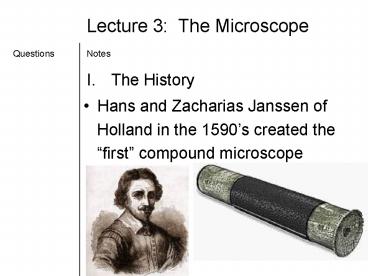Lecture 3: The Microscope - PowerPoint PPT Presentation
1 / 25
Title:
Lecture 3: The Microscope
Description:
The image passes through the body tube to a second lens, the ocular or eyepiece. ... A good study question is one you think I might ask on the next test. ... – PowerPoint PPT presentation
Number of Views:59
Avg rating:3.0/5.0
Title: Lecture 3: The Microscope
1
Lecture 3 The Microscope
Questions Notes
- The History
- Hans and Zacharias Janssen of
- Holland in the 1590s created the
- first compound microscope
2
- Anthony van Leeuwenhoek and Robert Hooke made
improvements by working on the lenses
3
II. How a Microscope Works
Convex Lenses are curved glass used to make
microscopes (and glasses etc.)
Convex Lenses bend light and focus it in one spot.
4
How a Microscope Works
Ocular Lens (Magnifies Image)
Objective Lens (Gathers Light, Magnifies And
Focuses Image Inside Body Tube)
Body Tube (Image Focuses)
- Bending Light The objective (bottom) convex lens
magnifies and focuses (bends) the image inside
the body tube and the ocular convex (top) lens
of a microscope magnifies it (again).
5
- Light passes from a mirror or a light source to
a specimen on a slide.
- The image is magnified by an objective lens.
- The image passes through the body tube to a
second lens, the ocular or eyepiece.
- The image is magnified a second time by the
eyepiece.
6
III. The Parts of the Microscope
- Write about each part AND its function
- Draw each part
7
Ocular Lens
Body Tube
Nose Piece
Arm
Objective Lenses
Stage
Stage Clips
Coarse Adj.
Diaphragm
Fine Adjustment
Light Source
Base
Skip to Magnification Section
8
Body Tube
- The body tube holds the objective lenses and the
ocular lens at the proper distance. The image
focuses here.
Diagram
9
Nose Piece
- The Nose Piece holds the objective lenses and can
be turned to increase the magnification
Diagram
10
Objective Lenses
- The Objective Lenses increase magnification
(usually from 10x to 40x)
Diagram
11
Stage Clips
- These 2 clips hold the slide/specimen in place on
the stage.
Diagram
12
Diaphragm
- The Diaphragm controls the amount of light on the
slide/specimen
Turn to let more light in or to make dimmer.
Diagram
13
Light Source
- Projects light upwards through the diaphragm, the
specimen and the lenses - Some have lights, others have mirrors where you
must move the mirror to reflect light
Diagram
14
Ocular Lens/Eyepiece
- Magnifies the specimen image
Diagram
15
Arm
- Used to support the microscope when carried.
Holds the body tube, nose piece and objective
lenses
Diagram
16
Stage
- Supports the slide/specimen
Diagram
17
Coarse Adjustment Knob
- Moves the stage up and down (quickly) for
focusing your image
Diagram
18
Fine Adjustment Knob
- This knob moves the stage SLIGHTLY to sharpen the
image
Diagram
19
Base
- Supports the microscope
Diagram
20
IV. Magnification
21
Magnification
- To determine your magnificationyou just multiply
the ocular lens by the objective lens - Ocular 10x Objective 40x10 x 40 400
So the object is 400 times larger
Objective Lens have their magnification written
on them.
Ocular lenses usually magnifies by 10x
22
V. Caring for a Microscope
- Clean only with a soft cloth/tissue
- Make sure its on a flat surface
- Dont bang it
- Carry it with 2 HANDSone on the arm and the
other on the base
23
Carry a Microscope Correctly
24
VI. Using a Microscope
- Start on the lowest magnification
- Dont use the coarse adjustment knob on high
magnificationyoull break the slide!!! - Place slide on stage and lock clips
- Adjust light source (if its a mirrordont stand
in front of it!) - Use fine adjustment to focus
25
Summary
- Write a 4-5 sentence summary of your notes. Be
specific and detailed. Write in your OWN words
and pick out the most important information. - Study Questions Write 10 good study questions
in the margin NEXT TO the answer. A good study
question is one you think I might ask on the next
test.

